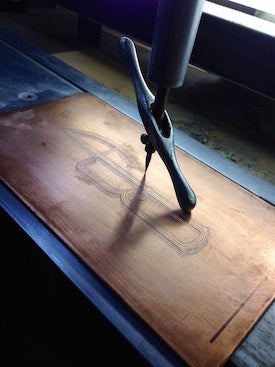About Us
The love of elegance and exquisite finish in stationery is no new love, but elegance and finish are not in themselves artistic,they are simply the last result of mere mechanical execution. We take especial pleasure, therefore, in calling attention to the work of Messrs.Dempsey & Carroll, who have earned for themselves the honourable designation of “Art Stationers.”
The Home Journal (Town & Country), 1879

Dempsey & Carroll has long been considered the finest purveyor of elegant engraved social stationery. In 1878, John Dempsey, a talented engraver, and George Carroll, a savvy businessman, collaborated on the founding of a company that would not only provide its customers with luxury writing papers but also offer advice on etiquette and proper decorum in a variety of social settings. To the founders, the social institutions of correspondence and etiquette were inseparable, and they saw Dempsey & Carroll as an ideal marriage of the two.
Prior to establishing the company, Mr. Dempsey enjoyed a reputation as one of the best engravers in New York City. Throughout his 30-year career, he engraved for nearly every prominent jeweler, stationer and bookseller in the New York metropolitan area. Mr. Carroll was a businessman with significant advertising experience, which he leveraged to help Dempsey & Carroll quickly reach its elite status. He realized that by writing books on social etiquette, the company could educate the public as well as advertise the brand and its products, becoming the authority on good taste and social decorum. These books and pamphlets were primarily written by Mr. Carroll and were engraved, typeset and printed by Dempsey & Carroll.

The first store and factory were located at 46 East 14th Street in Union Square between University Place and Broadway. The Sales Department was established in the building of the Meriden Britannia Company, a firm of silverware merchants. By February 1889, Dempsey & Carroll had moved around the corner and acquired the entire building at 36 East 14th Street to accommodate their quickly expanding enterprise. By that time, all printing and production took place on the upper floors, while the Sales Department occupied the ground floor.
Today, more than 130 years later, Dempsey & Carroll is still considered an authority on proper etiquette regarding everything from opulent wedding invitations to classic thank-you notes. With our history firmly rooted in this refined art form, Dempsey & Carroll remains dedicated to serving our customers and standing behind our truly exceptional products.
The Engraving Process
The term engraving can refer to any process in which metal or another hard surface is either incised (carved) or incused (hammered with a stamp). In some cases, the metal object is the final work. In other cases, the metal object is then used as a plate for printing onto paper. This is the type of engraving in which Dempsey & Carroll specializes.

